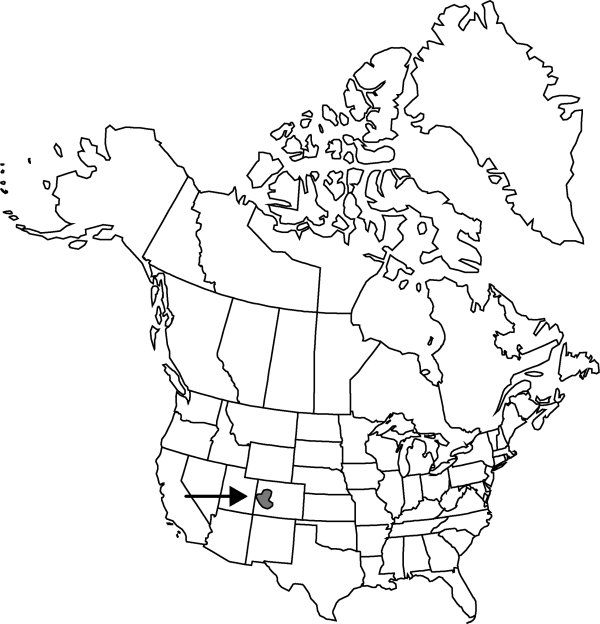Difference between revisions of "Sclerocactus glaucus"
Cact. Succ. J. (Los Angeles) 38: 53. 1966.
FNA>Volume Importer |
FNA>Volume Importer |
||
| Line 29: | Line 29: | ||
}}<!-- | }}<!-- | ||
| − | --><span class="statement" id="st- | + | --><span class="statement" id="st-undefined" data-properties=""><b>Stems </b>usually unbranched, cylindric to elongate cylindric, 3–12(–28) × 4–9 cm; ribs (8–)12–13(–15), tubercles evident on ribs. <b>Spines</b> slightly or not at all obscuring stems; radial spines (2–)6–8(–12) per areole, white, 0–17 mm; central spines 1–3(–5) per areole, sometimes not greatly different from radial spines; abaxial central spines 0–2 per areole, brown, reddish brown to black, straight (rarely curved or hooked), 12–26 × 0.8–1 mm; lateral central spines 2–4 per areole, similar to abaxial; adaxial central spine 1 per areole, usually white (rarely light brown), elliptic in cross section, 15–31 × 0.5–1.8 mm. <b>Flowers</b> fragrant, funnelform (rarely campanulate), 3–5(–6) × (3–)4–5 cm; outer tepals with greenish lavender midstripes and pink margins, oblanceolate, 25–30 × 4–6 mm; inner tepals pink (rarely pale pink), oblanceolate to lanceolate, 24–30(–35) × 4–6 mm; filaments green to white; anthers yellow. <b>Fruits</b> not regularly dehiscent, ovoid, barrel-shaped, 9–22(–30) × 8–12 mm, dry, with a few membranous scales, mostly near the apex. <b>Seeds</b> black, 1.5 × 2.5 mm; testa with rounded papillae.</span><!-- |
-->{{Treatment/Body | -->{{Treatment/Body | ||
| + | |phenology=Flowering late Apr–May. | ||
|habitat=Exposed, gravel-covered, clay hills, saltbush or sagebrush flats, or pinyon-juniper woodlands | |habitat=Exposed, gravel-covered, clay hills, saltbush or sagebrush flats, or pinyon-juniper woodlands | ||
|elevation=1400-2000 m | |elevation=1400-2000 m | ||
| Line 52: | Line 53: | ||
|basionyms=Echinocactus glaucus | |basionyms=Echinocactus glaucus | ||
|family=Cactaceae | |family=Cactaceae | ||
| + | |phenology=Flowering late Apr–May. | ||
|habitat=Exposed, gravel-covered, clay hills, saltbush or sagebrush flats, or pinyon-juniper woodlands | |habitat=Exposed, gravel-covered, clay hills, saltbush or sagebrush flats, or pinyon-juniper woodlands | ||
|elevation=1400-2000 m | |elevation=1400-2000 m | ||
| Line 59: | Line 61: | ||
|publication year=1966 | |publication year=1966 | ||
|special status= | |special status= | ||
| − | |source xml=https://jpend@bitbucket.org/aafc-mbb/fna- | + | |source xml=https://jpend@bitbucket.org/aafc-mbb/fna-data-curation.git/src/9216fc802291cd3df363fd52122300479582ede7/coarse_grained_fna_xml/V4/V4_374.xml |
|subfamily=Cactaceae subfam. Cactoideae | |subfamily=Cactaceae subfam. Cactoideae | ||
|genus=Sclerocactus | |genus=Sclerocactus | ||
|species=Sclerocactus glaucus | |species=Sclerocactus glaucus | ||
| − | |||
| − | |||
| − | |||
| − | |||
| − | |||
| − | |||
| − | |||
| − | |||
| − | |||
| − | |||
| − | |||
| − | |||
| − | |||
| − | |||
| − | |||
| − | |||
| − | |||
| − | |||
| − | |||
| − | |||
| − | |||
| − | |||
| − | |||
| − | |||
| − | |||
| − | |||
| − | |||
| − | |||
| − | |||
| − | |||
| − | |||
| − | |||
| − | |||
| − | |||
| − | |||
| − | |||
| − | |||
| − | |||
| − | |||
| − | |||
| − | |||
| − | |||
| − | |||
| − | |||
| − | |||
| − | |||
| − | |||
| − | |||
| − | |||
| − | |||
| − | |||
| − | |||
| − | |||
| − | |||
| − | |||
| − | |||
}}<!-- | }}<!-- | ||
-->[[Category:Treatment]][[Category:Sclerocactus]] | -->[[Category:Treatment]][[Category:Sclerocactus]] | ||
Revision as of 14:08, 27 July 2019
Stems usually unbranched, cylindric to elongate cylindric, 3–12(–28) × 4–9 cm; ribs (8–)12–13(–15), tubercles evident on ribs. Spines slightly or not at all obscuring stems; radial spines (2–)6–8(–12) per areole, white, 0–17 mm; central spines 1–3(–5) per areole, sometimes not greatly different from radial spines; abaxial central spines 0–2 per areole, brown, reddish brown to black, straight (rarely curved or hooked), 12–26 × 0.8–1 mm; lateral central spines 2–4 per areole, similar to abaxial; adaxial central spine 1 per areole, usually white (rarely light brown), elliptic in cross section, 15–31 × 0.5–1.8 mm. Flowers fragrant, funnelform (rarely campanulate), 3–5(–6) × (3–)4–5 cm; outer tepals with greenish lavender midstripes and pink margins, oblanceolate, 25–30 × 4–6 mm; inner tepals pink (rarely pale pink), oblanceolate to lanceolate, 24–30(–35) × 4–6 mm; filaments green to white; anthers yellow. Fruits not regularly dehiscent, ovoid, barrel-shaped, 9–22(–30) × 8–12 mm, dry, with a few membranous scales, mostly near the apex. Seeds black, 1.5 × 2.5 mm; testa with rounded papillae.
Phenology: Flowering late Apr–May.
Habitat: Exposed, gravel-covered, clay hills, saltbush or sagebrush flats, or pinyon-juniper woodlands
Elevation: 1400-2000 m
Discussion
Of conservation concern.
Sclerocactus glaucus is known only from Grand Junction area south to near Montrose, Colorado. The systematic and taxonomic confusion involving S. glaucus has been reviewed by K. D. Heil and J. M. Porter (1994); however, in their revision of Sclerocactus, S. wetlandicus was included within their circumscription of S. glaucus. Chloroplast DNA data (J. M. Porter et al. 2000) are consistent with F. Hochstätter’s (1997) assertion that these represent two taxa. Even so, S. glaucus and S. wetlandicus are morphologically very similar and in the herbarium may be very difficult to discriminate without resorting to scanning electron microscopy (SEM) or a determination based upon geography. The surface of the epidermal cells of S. wetlandicus and S. brevispinus is flattened; this can be observed easily at 20×, but only with some difficulty at 10×. The cells are convex with a flattened apex, like a hill that was strip mined, lacking the conoidal projection; whereas, those of S. glaucus are rounded.
Selected References
None.
